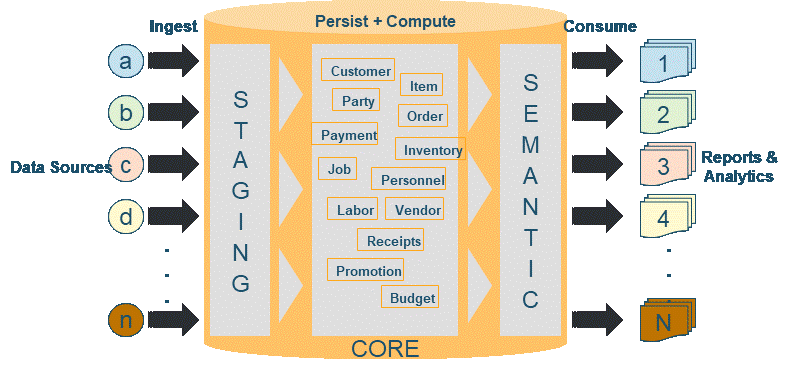AWS Big Data Blog
Tag: Amazon Redshift Spectrum
Accelerate Amazon Redshift Data Lake queries with AWS Glue Data Catalog Column Statistics
Over the last year, Amazon Redshift added several performance optimizations for data lake queries across multiple areas of query engine such as rewrite, planning, scan execution and consuming AWS Glue Data Catalog column statistics. In this post, we highlight the performance improvements we observed using industry standard TPC-DS benchmarks. Overall execution time of TPC-DS 3 TB benchmark improved by 3x. Some of the queries in our benchmark experienced up to 12x speed up.
Seamless integration of data lake and data warehouse using Amazon Redshift Spectrum and Amazon DataZone
Unlocking the true value of data often gets impeded by siloed information. Traditional data management—wherein each business unit ingests raw data in separate data lakes or warehouses—hinders visibility and cross-functional analysis. A data mesh framework empowers business units with data ownership and facilitates seamless sharing. However, integrating datasets from different business units can present several […]
Create, train, and deploy Amazon Redshift ML model integrating features from Amazon SageMaker Feature Store
Amazon Redshift is a fast, petabyte-scale, cloud data warehouse that tens of thousands of customers rely on to power their analytics workloads. Data analysts and database developers want to use this data to train machine learning (ML) models, which can then be used to generate insights on new data for use cases such as forecasting […]
Automate data archival for Amazon Redshift time series tables
Amazon Redshift is a fast, petabyte-scale cloud data warehouse that makes it simple and cost-effective to analyze all of your data using standard SQL. Tens of thousands of customers today rely on Amazon Redshift to analyze exabytes of data and run complex analytical queries, making it the most widely used cloud data warehouse. You can […]
Accelerate self-service analytics with Amazon Redshift Query Editor V2
August 2023: This post was reviewed and updated with new features. Amazon Redshift is a fast, fully managed cloud data warehouse. Tens of thousands of customers use Amazon Redshift as their analytics platform. Users such as data analysts, database developers, and data scientists use SQL to analyze their data in Amazon Redshift data warehouses. Amazon […]
Speed up data ingestion on Amazon Redshift with BryteFlow
This is a guest post by Pradnya Bhandary, Co-Founder and CEO at Bryte Systems. Data can be transformative for an organization. How and where you store your data for analysis and business intelligence is therefore an especially important decision that each organization needs to make. Should you choose an on-premises data warehouse solution or embrace […]
Manage and control your cost with Amazon Redshift Concurrency Scaling and Spectrum
This post shares the simple steps you can take to use the new Amazon Redshift usage controls feature to monitor and control your usage and associated cost for Amazon Redshift Spectrum and Concurrency Scaling features. Redshift Spectrum enables you to power a lake house architecture to directly query and join data across your data warehouse and data lake, and Concurrency Scaling enables you to support thousands of concurrent users and queries with consistently fast query performance.
Develop an application migration methodology to modernize your data warehouse with Amazon Redshift
This post demonstrates how to develop a comprehensive, wave-based application migration methodology for a complex project to modernize a traditional MPP data warehouse with Amazon Redshift. It provides best practices and lessons learned by considering business priority, data dependency, workload profiles and existing service level agreements (SLAs).
Restrict Amazon Redshift Spectrum external table access to Amazon Redshift IAM users and groups using role chaining
With Amazon Redshift Spectrum, you can query the data in your Amazon Simple Storage Service (Amazon S3) data lake using a central AWS Glue metastore from your Amazon Redshift cluster. This capability extends your petabyte-scale Amazon Redshift data warehouse to unbounded data storage limits, which allows you to scale to exabytes of data cost-effectively. Like Amazon EMR, you get the benefits of open data formats and inexpensive storage, and you can scale out to thousands of Redshift Spectrum nodes to pull data, filter, project, aggregate, group, and sort. Like Amazon Athena, Redshift Spectrum is serverless and there’s nothing to provision or manage. You only pay $5 for every 1 TB of data scanned. This post discusses how to configure Amazon Redshift security to enable fine grained access control using role chaining to achieve high-fidelity user-based permission management.
Working with nested data types using Amazon Redshift Spectrum
Redshift Spectrum is a feature of Amazon Redshift that allows you to query data stored on Amazon S3 directly and supports nested data types. This post discusses which use cases can benefit from nested data types, how to use Amazon Redshift Spectrum with nested data types to achieve excellent performance and storage efficiency, and some […]









